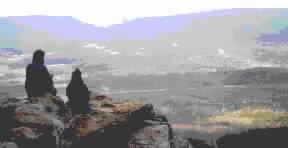|
 he
resort potential of the mountain was recognized early and many hotels
were built on the mountain in the late 1800s and early 1900s. The first
hotel was built in the 1850s by Col. Whiteside close to where the Scenic
Highway tops the mountain. In the 1880s, the most popular hotel on the
Mountain was The Natural Bridge Hotel. Another large hotel called The
Lookout Inn was built across from the present Incline station in 1890.
This hotel burned in 1908. In 1928, a castle-like hotel called the
Lookout Mountain Hotel was built on the west brow of the mountain. This
hotel is now Covenant College. Most of these hotels were not financially
successful. he
resort potential of the mountain was recognized early and many hotels
were built on the mountain in the late 1800s and early 1900s. The first
hotel was built in the 1850s by Col. Whiteside close to where the Scenic
Highway tops the mountain. In the 1880s, the most popular hotel on the
Mountain was The Natural Bridge Hotel. Another large hotel called The
Lookout Inn was built across from the present Incline station in 1890.
This hotel burned in 1908. In 1928, a castle-like hotel called the
Lookout Mountain Hotel was built on the west brow of the mountain. This
hotel is now Covenant College. Most of these hotels were not financially
successful.
The Current Incline
Incline #2
In 1895, the Whitesides built Incline #2 (the
current Incline Railway). Within 5 years, Incline #1 and the Broad Gauge
were out of business. While Incline #1 and The Narrow and Broad Gauge
Railroads are gone, the National Park incorporates a portion of these
railroad lines into its trail system as well as the site of The Point
Hotel.
The Most Popular Attraction on Lookout Mtn.
The Natural Bridge
In the late 1800s and early 1900s, the most popular
attractions on Lookout Mountain was The Natural Bridge. Located at the
north end of Lookout Mountain (just a mile from Sunset Rock, The Point,
and the Incline station), people came from far away to see this rock
structure and to drink its youth giving mineral water. In 1884, a
religious group called the Spiritualists purchased The Natural Bridge
Hotel and surrounding grounds. Midnight seances
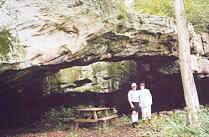 and
meetings where mediums talked to spirits were commonplace around The
Natural Bridge during the late 1880s. The Spiritualist sold the property
in 1890, but The Natural Bridge remained popular through the 1920s when
it was featured on penny postcards. Development in the area and the
popularity of the commercial attractions has caused this natural rock
phenomenon to be all but abandoned although people can still visit it if
they can find it. and
meetings where mediums talked to spirits were commonplace around The
Natural Bridge during the late 1880s. The Spiritualist sold the property
in 1890, but The Natural Bridge remained popular through the 1920s when
it was featured on penny postcards. Development in the area and the
popularity of the commercial attractions has caused this natural rock
phenomenon to be all but abandoned although people can still visit it if
they can find it.
The Birth of Miniature Golf
In the mid 1920s, two Chattanooga businessmen
started the Fairyland development, an exclusive subdivision situated on
the eastern brow of Lookout Mtn. about 3 miles south of The Point. The
subdivision included the Fairyland Inn and golf course.
One of these businessmen was Garnet Carter. Before
the golf course opened, Carter set up a putting green and in so doing
began experimenting with using pipes and rocks on a smaller course.
Shortly thereafter, his Tom Thumb miniature golf course was a great
success and miniature golf courses were going up all over the country.
By 1930, more than 25,000 miniature golf courses were in place around
the world and the Carters were multi-millionaires.
Rock City
The Fairyland subdivision included an area on the
eastern brow of the mountain that was well know for its unusual rock
formations. This area, called Rock City, had been a home to Indians in
times past and was on property owned by Garnet Carter and his wife
Frieda. Frieda loved to visit this place. In the late 1920s she began to
develop trails and plant flowers and shrubs in the Rock City. As time
went by, this place became more popular to residents and tourist alike.
Garnet, noticing the popularity of the place, decided to begin charging
admission and opened "Rock City" to the public in 1932.
Carter began an extensive advertising campaign. His
ingenuity at promotion was unmatched. He gave farmers across the country
free barn roof paint jobs. He designed and made a large number of Rock
City mail boxes. When postal authorities objected, he punched holes in
them converting the mail boxes into Rock City bird houses. At first, he
paid for his advertising, but soon people paid him for his advertising
by buying his Rock City souvenirs.
Ruby Falls
Lookout Mountain is known for its many caves. One
of the most well known is a huge, richly ornamented, cave at the north
end of the mountain. This cave was used for hundreds of years, by the
Indians and later by the Confederates during the Civil War. In 1905, the
railroad drilled a tunnel through the mountain which intersected the
cave opening. In 1910, the railroad sealed the entrance to the cave.
In the early 1920s, an entrepreneur named Leo
Lambert (who had visited the cave prior to its closure) decided the cave
could be a profitable tourist attraction if it could be reopened.
Lambert decided the only way to reopen the cave was to drill down to it.
In 1928, he purchase land on the side of the mountain (above the cave)
and started to drill. After a month of drilling through solid limestone,
the drilling crew came upon an unexpected cave (above where they
expected the main cave to be). The next day, Lambert and a few others
were lowered down the shaft. They made their way through the narrow wet
passages for about 600 feet until they could hear the roaring of falling
water. It was here they discovered a 100 foot underground waterfall.
Lambert decided to name the waterfall after his
wife Ruby. Drilling continued until they hit the main cave. Both caves
were opened to the public in 1930, but the depression took its toll and
Lambert's company went bankrupt and Ruby Falls was sold for $25,000 in
1932.
Originally, visitors could chose whether to visit
Ruby Falls or the lower cave (which extended several miles underground).
Ruby Fall, however, proved to be the most popular and the lower cave was
eventually closed. The castle-like building at the entrance to Ruby
Falls (Cavern Castle) was built with limestone taken from the shaft.
Mystery Falls
About a mile north of Ruby Falls (next to the
river) is a another huge cave and a spectacular 300 foot underground
waterfall called “Mystery Falls”. This waterfall was once used as a
water source for parts of Chattanooga and is not open to the public.
The Chickamauga and Chattanooga
National Military Park on Lookout Mountain
In 1893, the
Cravens House and 85 acres were deeded to the U.S. government for a
Park. In 1898, The Point and 16.5 acres were purchased from the
Whitesides and became Point Park. These two properties make up the
nucleus of the Park on Lookout Mountain. The Park also includes
thousands of wooded areas along the slopes of Lookout Mountain including
Sunset Rock. The Park is open to the public year-round.
Miscellaneous
Information
Lookout Mountain
The Narrow Gauge
Railroad
Built in 1885-86
The Narrow Guage Railroad went from The Point to Sunset
Rock to The Natural Bridge and in 1894 the track was extended to Lookout
Inn by putting a third rail in the Broad Gauge track.
Incline #1 (The
Original Incline)
Built 1885-1887 (18 months to build) Cost about $150,000
to build
Opened - Mar. 12, 1887 Closed July 3, 1899
4,360 feet long with 3 tracks
150,000 people rode it in 1890
Prices - Adult round-trip 50c Children 25c
33% max. grade (Incline #2 has a 72% max. grade)
The Broad Gauge
Railroad
Built in 1887-1888 (18 months to build)
First ride to top Jan 19, 1889 Closed 1899
Purchased by Incline #1 owners in 1887
Electric Street Car operated along this line from 1913 to 1920
The Point Hotel
4 stories
The Basement housed - Barber Shop - Billiard Room - Bath House
1st Floor - Lobby - Office - Dinning Room - Narrow Gauge Track
2nd Floor - Parlor 28 guest rooms
3rd Floor - 30 guest rooms
$2.50 - $4 per night
The Lookout Inn
360 feet long
Built across from Incline station
Opened June 1890 Burned Nov 1908
Incline #2 (The current Incline)
Opened Nov 12, 1895
4,800 feet long or 9/10 mile
Built by the Whitesides
Owners purchased Broad Gauge in Sept 1897
and Incline #1 in June 1899. They closed both in 1899
The Lookout Mountain Hotel
(Covenant College)
Opened June 23, 1928
412 foot tower
200 guest rooms
Closed early 1930s
Reopened and closed several times
Renamed Castle Above the Clouds in 1957
Became Covenant College in 1964
The History of
Chattanooga
and Lookout Mountain
The Mountain
Ownership of
Lookout Mountain
Mid to Late 1800's
|
 uring
the mid and latter part of the 1800’s, most of Lookout Mountain
lying in Tennessee was owned by the Whiteside and Cravens
families. uring
the mid and latter part of the 1800’s, most of Lookout Mountain
lying in Tennessee was owned by the Whiteside and Cravens
families.
In 1840, the state of Tennessee auctioned
off the property formerly owned by the Cherokee Indians. Due to
the lack of any roads up Lookout Mountain, Whiteside faced
little competition in bidding for the property on this property.
He purchased most of the mountain lying in Tennessee, paying as
little at 1c an acre for some of it.
In the mid 1850s, Robert Cravens purchased
property on the northern talus of the mountain and built the
house that today bears his name. By the 1880s, he owned almost
the entire northern slope of the mountain. His property ran from
the Palisades to the River and across to the Incline tracks. At
the time of the Civil War, about 30 families lived on the
mountain during the summer and about half that many year round.
The Turnpike and Incline
Wars
The
Road Up Lookout Mountain
Col. Whiteside build a toll road up the
eastern side of the mountain in the 1850s (called the Whiteside
Turnpike and the Summertown Road during the Civil War). The road
ran up the mountain beginning near the present Incline and
crested the mountain where the current Scenic Hwy reaches the
top. At this location, on top of the mountain, was the
Summertown community where wealthy families spent much of their
summers. The Whiteside Turnpike was the only road up the
northern end of the mountain during the Civil War. It remained
the only road until 1879, one year after the deadly Yellow Fever
Epidemic in Chattanooga.
The Yellow
Fever Epidemic
In 1878, the Yellow Fever Epidemic hit
Chattanooga. Chattanooga was thought to be immune, due to its
mountain climate. However, after the death of a child and his
mother of the Fever, nearly all the nearly 12,000 people fled
the city in panic. The scare lasted nearly two months and 366
people died. Lookout Mountain, known for its healthy climate,
was where many of the people fled. To get there, though, they
had to travel the Whiteside Turnpike and pay the high toll.
Later, many of these people complained about the toll and the
next year the St. Elmo Turnpike (now called Ochs Highway) was
built up the mountain.
This resulted in fewer people using the
Whiteside Turnpike and a loss of toll revenues for the
Whitesides. To make up for this loss, the Whitesides decided to
charge for access to The Point. (fyi- The Scenic Hwy was
built in the late 1920s)
|
The
Spectacular View from The Point
Immediately after
the Civil War, a photographer named Robert Linn set up
his studio at The Point. Thousands of soldiers climbed
the mountain to have their photographs taken on The
Point, with its spectacular and panoramic backdrop. Most
of the Union Generals (and many of the Confederate
Generals), including Grant, Hooker, Thomas, Rosecrans,
and Sherman, had their photographs taken here. When
these soldiers went home, their stories about the
magnificent views, along with these pictures, made
Lookout Mountain one of the most popular tourist
attractions in the country and the world (long before
any of the popular attractions). |
Lookout Mountain's First
Commercial Attraction
The Point
During the late 1800s, the primary reason
many people came to Lookout Mountain was to see the spectacular
view from The Point (now called Point Park). When confronted
with having to pay to experience this natural wonder, many
refused. Others began forcing their way onto the property. In
response, the Whitesides erected a fence and hired armed guards
to stand watch.
In addition, the Whitesides contracted with
the Owen Livery Company in Chattanooga to take passengers up the
mountain (along the Whiteside
 Turnpike).
The contract prevented anyone, except those who rode up on
Owen's Livery, to visit The Point. This outraged competing
Livery owners, as well as other real estate interest on Lookout
Mountain. Turnpike).
The contract prevented anyone, except those who rode up on
Owen's Livery, to visit The Point. This outraged competing
Livery owners, as well as other real estate interest on Lookout
Mountain.
The First
Incline
Incline #1
As a result of these events, a group of
investors decided to build a hotel off the edge of the mountain
immediately below The Point. This hotel would tower to the same
level and give patrons the same view as The Point.
 To
build the hotel, however, they needed a way to get building
materials up the mountain, and then a convenient way to get
customers to the hotel. To do this, they built the first Incline
up the mountain. Incline #1 was built in 1887 (the current
incline is Incline #2). The Incline #1 station was located just
a few hundred yards north of the current Incline station (at the
bottom of the mountain). It ran up the mountain to just below
The Point. The Point Hotel served as the Incline station at the
top of the mountain. To
build the hotel, however, they needed a way to get building
materials up the mountain, and then a convenient way to get
customers to the hotel. To do this, they built the first Incline
up the mountain. Incline #1 was built in 1887 (the current
incline is Incline #2). The Incline #1 station was located just
a few hundred yards north of the current Incline station (at the
bottom of the mountain). It ran up the mountain to just below
The Point. The Point Hotel served as the Incline station at the
top of the mountain.
Incline #1 in 1888 Visitor's Guide
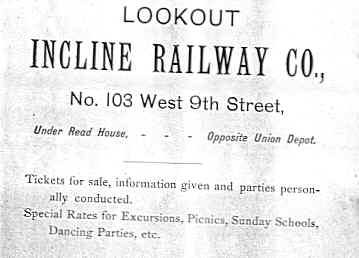
The
Hotel Built Off
the Side of the Mountain
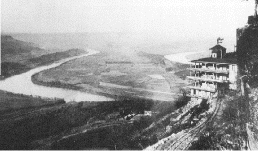 The
Point Hotel, built off the side of the mountain just below The
Point, had 4 stories and 58 rooms. It opened in May 1888. The
rates ran from $2.50 to $4 per night. To get to the hotel, a
round-trip on the Incline #1 cost 50c for adults and 25c for
children. The Point Hotel was built at the base of the Palisades
(a 75+ foot rock cliff that surrounds the top of the mountain)
and the competing Whitesides owned the property immediately
above. This presented a dilemma because the Hotel owners needed
a way to get patrons to the top of the mountain. The solution to
this dilemma was a small train. The
Point Hotel, built off the side of the mountain just below The
Point, had 4 stories and 58 rooms. It opened in May 1888. The
rates ran from $2.50 to $4 per night. To get to the hotel, a
round-trip on the Incline #1 cost 50c for adults and 25c for
children. The Point Hotel was built at the base of the Palisades
(a 75+ foot rock cliff that surrounds the top of the mountain)
and the competing Whitesides owned the property immediately
above. This presented a dilemma because the Hotel owners needed
a way to get patrons to the top of the mountain. The solution to
this dilemma was a small train.
The Point Hotel in 1988 Visitor's Guide
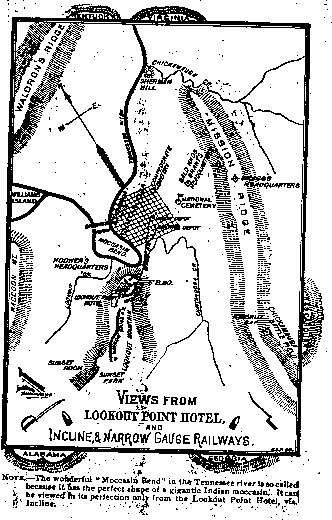
The Small Train on The Mountain
To afford patrons access to the top of the
mountain, The Narrow Gauge Railroad was built in 1887
(essentially a small train). It ran from The Point Hotel along
the base of the western Palisades for 1/2 mile. At this point it
ran up though a gap in the Palisades to the top of the mountain.
The Narrow Gauge Railroad then ran to Sunset Rock and ended at
the popular tourist attraction, The Natural Bridge. In 1894 its
tracks were extended from The Natural Bridge to the Lookout Inn
on the eastern side of the Mountain.
The Train Up the Mountain
In the late 1880s, Lookout Mountain was
becoming very popular, to both residents and tourists. A
competing investor group decided that a better way up the
mountain was a regular train. The Broad Gauge Railroad carrying
passengers to the top of Lookout Mountain was finished in 1889.
This railroad began its climb up the
mountain on the east side in St. Elmo (a few hundred yards south
of the current Incline station). It ran north up and
 around
the talus of the mountain (going under Incline #1) to a
switchback on the western slope. It then proceeded back up and
around the talus of the mountain (running in front of The
Cravens House and then under Incline #1 again) to the top of the
mountain (cresting where Oches Highway now tops the mountain).
The tracks then ran west across the top of the mountain to
Sunset Park, then back east past The Natural Bridge, ending at
the Lookout Inn (which was owned by the Broad Gauge investor
group). around
the talus of the mountain (going under Incline #1) to a
switchback on the western slope. It then proceeded back up and
around the talus of the mountain (running in front of The
Cravens House and then under Incline #1 again) to the top of the
mountain (cresting where Oches Highway now tops the mountain).
The tracks then ran west across the top of the mountain to
Sunset Park, then back east past The Natural Bridge, ending at
the Lookout Inn (which was owned by the Broad Gauge investor
group). |
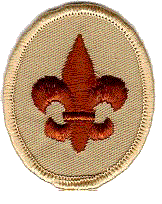  
|






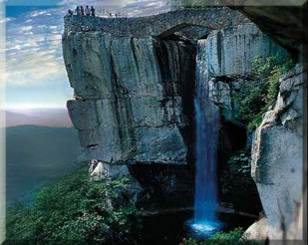
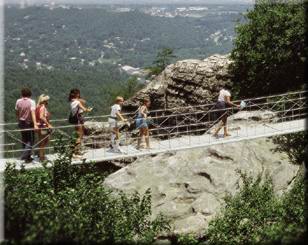
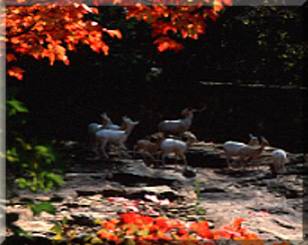
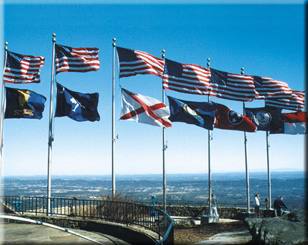
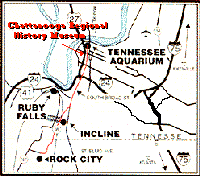

![]()
![]()
